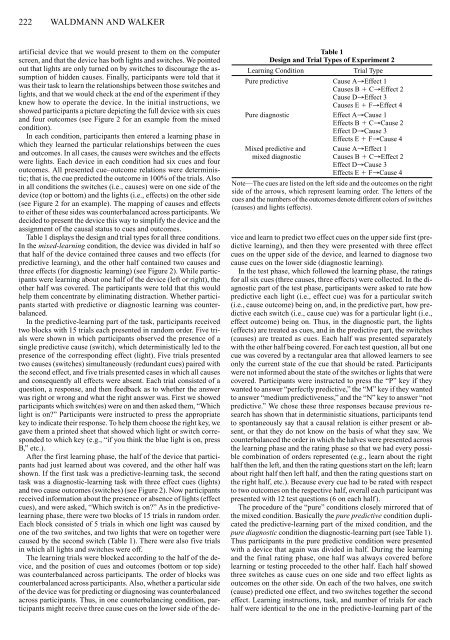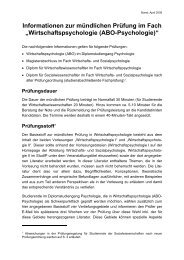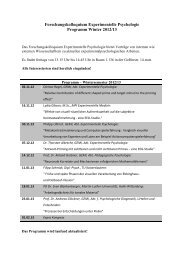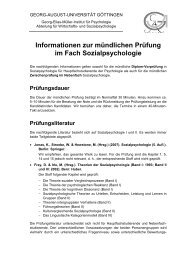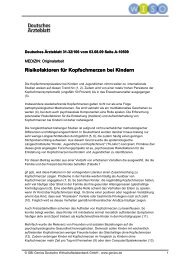Competence and performance in causal learning
Competence and performance in causal learning
Competence and performance in causal learning
Create successful ePaper yourself
Turn your PDF publications into a flip-book with our unique Google optimized e-Paper software.
222 WALDMANN AND WALKER<br />
Table 1<br />
Design <strong>and</strong> Trial Types of Experiment 2<br />
Learn<strong>in</strong>g Condition<br />
Trial Type<br />
Pure predictive Cause A→Effect 1<br />
Causes B C→Effect 2<br />
Cause D→Effect 3<br />
Causes E F→Effect 4<br />
Pure diagnostic Effect A→Cause 1<br />
Effects B C→Cause 2<br />
Effect D→Cause 3<br />
Effects E F→Cause 4<br />
Mixed predictive <strong>and</strong> Cause A→Effect 1<br />
mixed diagnostic Causes B C→Effect 2<br />
Effect D→Cause 3<br />
Effects E F→Cause 4<br />
Note—The cues are listed on the left side <strong>and</strong> the outcomes on the right<br />
side of the arrows, which represent learn<strong>in</strong>g order. The letters of the<br />
cues <strong>and</strong> the numbers of the outcomes denote different colors of switches<br />
(causes) <strong>and</strong> lights (effects).<br />
artificial device that we would present to them on the computer<br />
screen, <strong>and</strong> that the device has both lights <strong>and</strong> switches. We po<strong>in</strong>ted<br />
out that lights are only turned on by switches to discourage the assumption<br />
of hidden causes. F<strong>in</strong>ally, participants were told that it<br />
was their task to learn the relationships between those switches <strong>and</strong><br />
lights, <strong>and</strong> that we would check at the end of the experiment if they<br />
knew how to operate the device. In the <strong>in</strong>itial <strong>in</strong>structions, we<br />
showed participants a picture depict<strong>in</strong>g the full device with six cues<br />
<strong>and</strong> four outcomes (see Figure 2 for an example from the mixed<br />
condition).<br />
In each condition, participants then entered a learn<strong>in</strong>g phase <strong>in</strong><br />
which they learned the particular relationships between the cues<br />
<strong>and</strong> outcomes. In all cases, the causes were switches <strong>and</strong> the effects<br />
were lights. Each device <strong>in</strong> each condition had six cues <strong>and</strong> four<br />
outcomes. All presented cue–outcome relations were determ<strong>in</strong>istic;<br />
that is, the cue predicted the outcome <strong>in</strong> 100% of the trials. Also<br />
<strong>in</strong> all conditions the switches (i.e., causes) were on one side of the<br />
device (top or bottom) <strong>and</strong> the lights (i.e., effects) on the other side<br />
(see Figure 2 for an example). The mapp<strong>in</strong>g of causes <strong>and</strong> effects<br />
to either of these sides was counterbalanced across participants. We<br />
decided to present the device this way to simplify the device <strong>and</strong> the<br />
assignment of the <strong>causal</strong> status to cues <strong>and</strong> outcomes.<br />
Table 1 displays the design <strong>and</strong> trial types for all three conditions.<br />
In the mixed-learn<strong>in</strong>g condition, the device was divided <strong>in</strong> half so<br />
that half of the device conta<strong>in</strong>ed three causes <strong>and</strong> two effects (for<br />
predictive learn<strong>in</strong>g), <strong>and</strong> the other half conta<strong>in</strong>ed two causes <strong>and</strong><br />
three effects (for diagnostic learn<strong>in</strong>g) (see Figure 2). While participants<br />
were learn<strong>in</strong>g about one half of the device (left or right), the<br />
other half was covered. The participants were told that this would<br />
help them concentrate by elim<strong>in</strong>at<strong>in</strong>g distraction. Whether participants<br />
started with predictive or diagnostic learn<strong>in</strong>g was counterbalanced.<br />
In the predictive-learn<strong>in</strong>g part of the task, participants received<br />
two blocks with 15 trials each presented <strong>in</strong> r<strong>and</strong>om order. Five trials<br />
were shown <strong>in</strong> which participants observed the presence of a<br />
s<strong>in</strong>gle predictive cause (switch), which determ<strong>in</strong>istically led to the<br />
presence of the correspond<strong>in</strong>g effect (light). Five trials presented<br />
two causes (switches) simultaneously (redundant cues) paired with<br />
the second effect, <strong>and</strong> five trials presented cases <strong>in</strong> which all causes<br />
<strong>and</strong> consequently all effects were absent. Each trial consisted of a<br />
question, a response, <strong>and</strong> then feedback as to whether the answer<br />
was right or wrong <strong>and</strong> what the right answer was. First we showed<br />
participants which switch(es) were on <strong>and</strong> then asked them, “Which<br />
light is on?” Participants were <strong>in</strong>structed to press the appropriate<br />
key to <strong>in</strong>dicate their response. To help them choose the right key, we<br />
gave them a pr<strong>in</strong>ted sheet that showed which light or switch corresponded<br />
to which key (e.g., “if you th<strong>in</strong>k the blue light is on, press<br />
B,” etc.).<br />
After the first learn<strong>in</strong>g phase, the half of the device that participants<br />
had just learned about was covered, <strong>and</strong> the other half was<br />
shown. If the first task was a predictive-learn<strong>in</strong>g task, the second<br />
task was a diagnostic-learn<strong>in</strong>g task with three effect cues (lights)<br />
<strong>and</strong> two cause outcomes (switches) (see Figure 2). Now participants<br />
received <strong>in</strong>formation about the presence or absence of lights (effect<br />
cues), <strong>and</strong> were asked, “Which switch is on?” As <strong>in</strong> the predictivelearn<strong>in</strong>g<br />
phase, there were two blocks of 15 trials <strong>in</strong> r<strong>and</strong>om order.<br />
Each block consisted of 5 trials <strong>in</strong> which one light was caused by<br />
one of the two switches, <strong>and</strong> two lights that were on together were<br />
caused by the second switch (Table 1). There were also five trials<br />
<strong>in</strong> which all lights <strong>and</strong> switches were off.<br />
The learn<strong>in</strong>g trials were blocked accord<strong>in</strong>g to the half of the device,<br />
<strong>and</strong> the position of cues <strong>and</strong> outcomes (bottom or top side)<br />
was counterbalanced across participants. The order of blocks was<br />
counterbalanced across participants. Also, whether a particular side<br />
of the device was for predict<strong>in</strong>g or diagnos<strong>in</strong>g was counterbalanced<br />
across participants. Thus, <strong>in</strong> one counterbalanc<strong>in</strong>g condition, participants<br />
might receive three cause cues on the lower side of the device<br />
<strong>and</strong> learn to predict two effect cues on the upper side first (predictive<br />
learn<strong>in</strong>g), <strong>and</strong> then they were presented with three effect<br />
cues on the upper side of the device, <strong>and</strong> learned to diagnose two<br />
cause cues on the lower side (diagnostic learn<strong>in</strong>g).<br />
In the test phase, which followed the learn<strong>in</strong>g phase, the rat<strong>in</strong>gs<br />
for all six cues (three causes, three effects) were collected. In the diagnostic<br />
part of the test phase, participants were asked to rate how<br />
predictive each light (i.e., effect cue) was for a particular switch<br />
(i.e., cause outcome) be<strong>in</strong>g on, <strong>and</strong>, <strong>in</strong> the predictive part, how predictive<br />
each switch (i.e., cause cue) was for a particular light (i.e.,<br />
effect outcome) be<strong>in</strong>g on. Thus, <strong>in</strong> the diagnostic part, the lights<br />
(effects) are treated as cues, <strong>and</strong> <strong>in</strong> the predictive part, the switches<br />
(causes) are treated as cues. Each half was presented separately<br />
with the other half be<strong>in</strong>g covered. For each test question, all but one<br />
cue was covered by a rectangular area that allowed learners to see<br />
only the current state of the cue that should be rated. Participants<br />
were not <strong>in</strong>formed about the state of the switches or lights that were<br />
covered. Participants were <strong>in</strong>structed to press the “P” key if they<br />
wanted to answer “perfectly predictive,” the “M” key if they wanted<br />
to answer “medium predictiveness,” <strong>and</strong> the “N” key to answer “not<br />
predictive.” We chose these three responses because previous research<br />
has shown that <strong>in</strong> determ<strong>in</strong>istic situations, participants tend<br />
to spontaneously say that a <strong>causal</strong> relation is either present or absent,<br />
or that they do not know on the basis of what they saw. We<br />
counterbalanced the order <strong>in</strong> which the halves were presented across<br />
the learn<strong>in</strong>g phase <strong>and</strong> the rat<strong>in</strong>g phase so that we had every possible<br />
comb<strong>in</strong>ation of orders represented (e.g., learn about the right<br />
half then the left, <strong>and</strong> then the rat<strong>in</strong>g questions start on the left; learn<br />
about right half then left half, <strong>and</strong> then the rat<strong>in</strong>g questions start on<br />
the right half, etc.). Because every cue had to be rated with respect<br />
to two outcomes on the respective half, overall each participant was<br />
presented with 12 test questions (6 on each half).<br />
The procedure of the “pure” conditions closely mirrored that of<br />
the mixed condition. Basically the pure predictive condition duplicated<br />
the predictive-learn<strong>in</strong>g part of the mixed condition, <strong>and</strong> the<br />
pure diagnostic condition the diagnostic-learn<strong>in</strong>g part (see Table 1).<br />
Thus participants <strong>in</strong> the pure predictive condition were presented<br />
with a device that aga<strong>in</strong> was divided <strong>in</strong> half. Dur<strong>in</strong>g the learn<strong>in</strong>g<br />
<strong>and</strong> the f<strong>in</strong>al rat<strong>in</strong>g phase, one half was always covered before<br />
learn<strong>in</strong>g or test<strong>in</strong>g proceeded to the other half. Each half showed<br />
three switches as cause cues on one side <strong>and</strong> two effect lights as<br />
outcomes on the other side. On each of the two halves, one switch<br />
(cause) predicted one effect, <strong>and</strong> two switches together the second<br />
effect. Learn<strong>in</strong>g <strong>in</strong>structions, task, <strong>and</strong> number of trials for each<br />
half were identical to the one <strong>in</strong> the predictive-learn<strong>in</strong>g part of the


